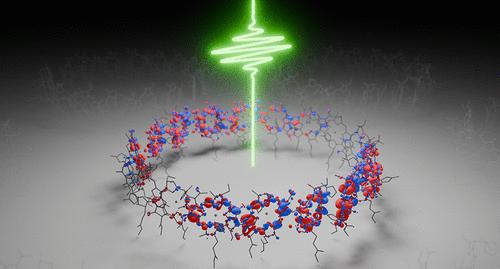Time-Resolved Ultrafast Excitation Dynamics in the B850 Light-Harvesting Antenna from Density Functional Theory
IF 4.6
2区 化学
Q2 CHEMISTRY, PHYSICAL
引用次数: 0
Abstract
Antenna complexes absorb sunlight and transfer the harvested energy with remarkable quantum efficiency. In spectroscopic experiments, they are typically excited with laser pulses that differ substantially from sunlight. Using density functional theory calculations in real time, we reveal the excitation dynamics that results in the B850 antenna ring of the purple bacterium Rhodoblastus acidophilus upon excitation by a short, strong pulse as typically used in experiments. The pulse dominantly triggers the exciton modes that are also the most relevant ones in the natural process. Quantum mechanical interference patterns noticeably influence the electronic density distribution after about 40 fs, and on the same time scale, the effects of nuclear motion start to have a noticeable influence on the excitation dynamics. About 20 fs after the laser peak, the B850 ring transitions into dynamics in which the excitation energy is mostly localized on segments that comprise just a few bacteriochlorophyll molecules.

基于密度泛函理论的B850光收集天线时间分辨超快激励动力学
天线复合物吸收阳光并以显著的量子效率转移所收集的能量。在光谱实验中,它们通常是用与太阳光有很大不同的激光脉冲激发的。利用密度泛函理论的实时计算,揭示了紫色细菌嗜酸Rhodoblastus acidophilus在实验中通常使用的短强脉冲激励下B850天线环的激励动力学。脉冲主要触发激子模式,这也是自然过程中最相关的模式。量子力学干涉图样在约40fs后对电子密度分布有显著影响,在同一时间尺度上,核运动的影响开始对激发动力学产生显著影响。在激光峰值后约20fs, B850环转变为动力学,其中激发能量主要集中在仅包含少数细菌叶绿素分子的片段上。
本文章由计算机程序翻译,如有差异,请以英文原文为准。
求助全文
约1分钟内获得全文
求助全文
来源期刊

The Journal of Physical Chemistry Letters
CHEMISTRY, PHYSICAL-NANOSCIENCE & NANOTECHNOLOGY
CiteScore
9.60
自引率
7.00%
发文量
1519
审稿时长
1.6 months
期刊介绍:
The Journal of Physical Chemistry (JPC) Letters is devoted to reporting new and original experimental and theoretical basic research of interest to physical chemists, biophysical chemists, chemical physicists, physicists, material scientists, and engineers. An important criterion for acceptance is that the paper reports a significant scientific advance and/or physical insight such that rapid publication is essential. Two issues of JPC Letters are published each month.
 求助内容:
求助内容: 应助结果提醒方式:
应助结果提醒方式:


